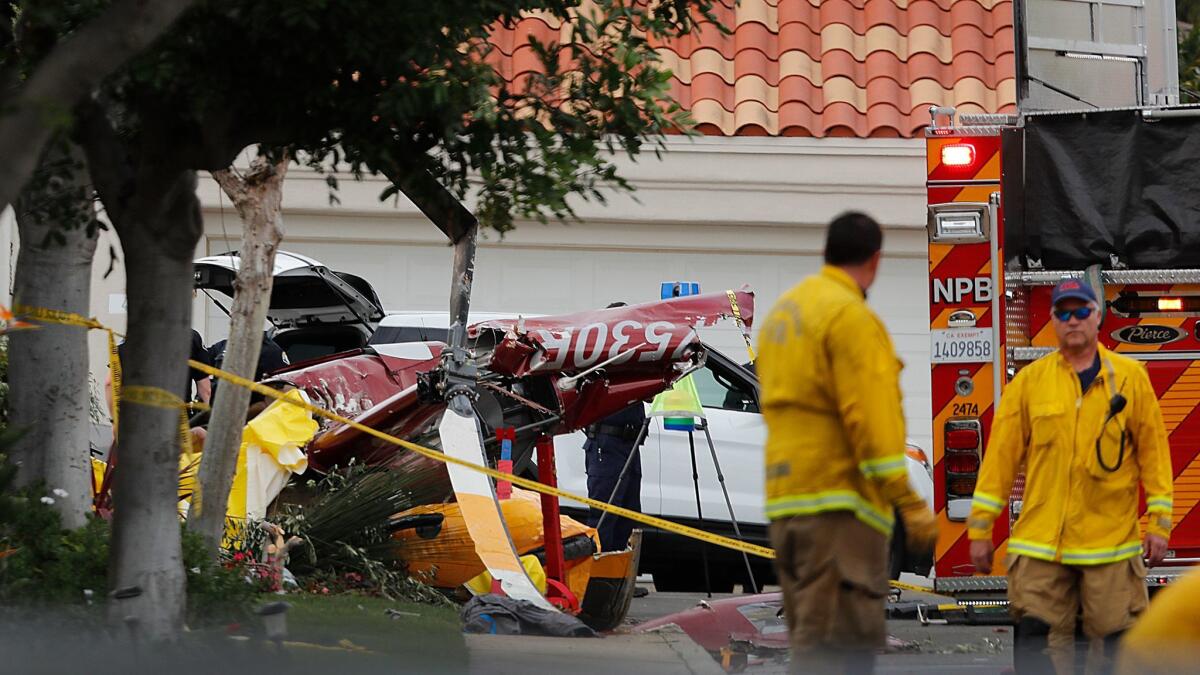Excess, imbalanced weight caused 2018 Newport helicopter crash, NTSB says

- Share via
A helicopter that went down in a Newport Beach neighborhood in 2018 crashed because it was slightly overweight and imbalanced, according to the National Transportation Safety Board.
The crash, which killed three people including the pilot and left a fourth passenger seriously injured, happened on Jan. 30, 2018, just after takeoff from John Wayne Airport en route to Catalina Island for a quick lunchtime pleasure trip. The four-seat Robinson 44 Clipper I weighed 2,476 pounds at liftoff, including fuel, occupants and baggage. That put it 76 pounds over its limit for safe, controlled operation, and with a forward center of gravity.
The final NTSB report, published April 8 — more than two years after the incident — says an examination of the airframe, engine and related systems showed no evidence of preexisting mechanical malfunctions or failures.
“The [surviving] passenger stated that the pilot did not ask any of the passengers for their weights, nor did he instruct them where to sit, suggesting that the pilot did not perform weight and balance calculations before the flight,” the report says. “Given the lack of mechanical anomalies, it is likely that the pilot experienced a loss of helicopter control due to his decision to operate the helicopter outside of its published weight and balance limitations.”
Surveillance video of the takeoff showed that the helicopter assumed a nose-low position upon liftoff and mostly maintained that position throughout the takeoff and initial climb. This tilt is consistent with a forward center of gravity, the report says.
“Helicopter performance is not only affected by gross weight, but also by the position of that weight,” the report concludes. “The pilot should ensure that the helicopter is properly balanced within its center of gravity limitations... Since the fuselage acts as a pendulum suspended from the rotor, changing the [center of gravity] changes the angle at which the aircraft hangs from the rotor. If the [center of gravity] is too far forward of the mast, the helicopter hangs with its nose tilted down.”
Radar data showed that the helicopter got about 500 feet above the ground before it began its rapid descent, which the surviving passenger described to investigators as “straight down.” The crash happened about a minute after takeoff, less than a mile from the airport. The pilot did not make any distress calls.
The survivor told police that the pilot told the group “something’s wrong” and apologized.
The aircraft clipped the roofs of two houses and hit the side of a home on Egret Court near Shearwater Place in the Bayview Terrace community. A person on the ground also suffered minor injuries.
The R44 was leased to Revolution Aviation — a flight school and touring company at JWA — from Spitzer Helicopter LLC of Canyon Lake in Riverside County, according to public records. Revolution Aviation later changed its name to One Above Aviation. It has since gone out of business.
All the latest on Orange County from Orange County.
Get our free TimesOC newsletter.
You may occasionally receive promotional content from the Daily Pilot.




